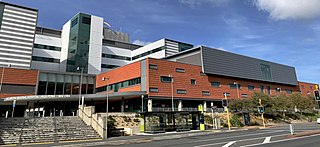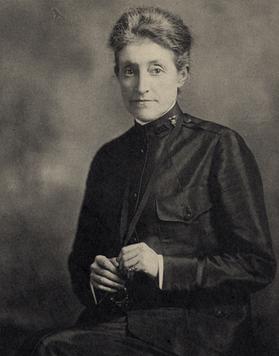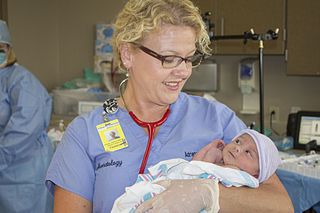
Vermillion County lies in the western part of the U.S. state of Indiana between the Illinois border and the Wabash River. As of the 2020 census, the population was 15,439. The county seat is Newport. It was officially established in 1824 and was the fiftieth Indiana county created. Vermillion County is included in the Terre Haute, Indiana, Metropolitan Statistical Area. The county contains seven incorporated towns with a total population of about 9,900. as well as several unincorporated communities; it is also divided into five townships which provide local services. An interstate highway, two U.S. routes, and five state roads cross the county, as does a major railroad line.

Terre Haute is a city in and the county seat of Vigo County, Indiana, United States, about 5 miles (8 km) east of the state's western border with Illinois. As of the 2020 census, the city had a population of 58,389 and its metropolitan area had a population of 168,716.

The Indiana University School of Medicine (IUSM) is a major, multi-campus medical school located throughout the U.S. state of Indiana and is the graduate medical school of Indiana University. There are nine campuses throughout the state; the principal research, educational, and medical center is located on the Indiana University–Purdue University Indianapolis (IUPUI) campus in Indianapolis. With 1,461 MD students, 195 PhD students, and 1,442 residents and fellows in the 2023–24 academic year, IUSM is the largest medical school in the United States. The school offers many joint degree programs including an MD/PhD Medical Scientist Training Program. It has partnerships with Purdue University's Weldon School of Biomedical Engineering, other Indiana University system schools, and various in-state external institutions. It is the medical school with the largest number of graduates licensed in the United States per a 2018 Federation of State Medical Boards survey with 11,828 licensed physicians.

A neonatal intensive care unit (NICU), also known as an intensive care nursery (ICN), is an intensive care unit (ICU) specializing in the care of ill or premature newborn infants. The NICU is divided into several areas, including a critical care area for babies who require close monitoring and intervention, an intermediate care area for infants who are stable but still require specialized care, and a step down unit where babies who are ready to leave the hospital can receive additional care before being discharged.

Wellington Hospital, also known as Wellington Regional Hospital, is the main hospital in Wellington, New Zealand, located south of the city centre in the suburb of Newtown. It is the main hospital run by Te Whatu Ora, Capital, Coast and Hutt Valley.

Neonatal nursing is a sub-specialty of nursing care for newborn infants up to 28 days after birth. The term neonatal comes from neo, "new", and natal, "pertaining to birth or origin". Neonatal nursing requires a high degree of skill, dedication and emotional strength as they care for newborn infants with a range of problems. These problems vary between prematurity, birth defects, infection, cardiac malformations and surgical issues. Neonatal nurses are a vital part of the neonatal care team and are required to know basic newborn resuscitation, be able to control the newborn's temperature and know how to initiate cardiopulmonary and pulse oximetry monitoring. Most neonatal nurses care for infants from the time of birth until they are discharged from the hospital.

Linda Richards was the first professionally trained American nurse. She established nursing training programs in the United States and Japan, and created the first system for keeping individual medical records for hospitalized patients.
Spartanburg Regional Healthcare System(SRHS) is one of South Carolina's largest healthcare systems. SRHS draws patients primarily from the areas of Spartanburg, Cherokee, Union, and Greenville counties (all located in the Piedmont region of South Carolina), as well as Rutherford and Polk counties (located in western North Carolina). Spartanburg General Hospital was organized under the authority of the South Carolina General Assembly in 1917. It officially became the Spartanburg Regional Health Services District, Inc., a political subdivision of the State of South Carolina, by the charter granted by the Secretary of State of South Carolina on May 1, 1995.

Orville Lynn Majors was a licensed practical nurse and serial killer who was convicted of murdering his patients in Clinton, Indiana. Though he was tried for only seven murders and convicted of six, he was believed to have caused additional deaths between 1993 and 1995, when he was employed by the hospital at which the deaths occurred and for which he was investigated. It was reported that he murdered patients who he claimed were demanding, whiny, or disproportionately adding to his work load.

Saint Luke's Hospital of Kansas City is a tertiary care hospital is located at 4401 Wornall Road in Kansas City, Missouri. It is part of the Saint Luke's Health System.

Mother Gertrude Clare Owens, S.P., was the Superior General of the Sisters of Providence of Saint Mary-of-the-Woods, Indiana, from 1954 to 1960. During her term, she established a sister-formation program to help develop new postulants and novices. She also built a new novitiate at Saint Mary-of-the-Woods, which was later named Owens Hall in her honor.

The Iloilo Mission Hospital, referred to as CPU–IMH, IMH, or Mission, is a private tertiary, academic, teaching hospital in Jaro, Iloilo City, Philippines, managed and operated as the university hospital of Central Philippine University. It was established in 1901 by American missionary doctor Joseph Andrew Hall as "the first Protestant and American-founded hospital in the country".

The United States Army Nurse Corps (USANC) was formally established by the U.S. Congress in 1901. It is one of the six medical special branches of officers which – along with medical enlisted soldiers – comprise the Army Medical Department (AMEDD). The ANC is the nursing service for the U.S. Army and provides nursing staff in support of the Department of Defense medical plans. The ANC is composed entirely of Registered Nurses (RNs) but also includes Nurse Practitioners.
Ruth Watson Lubic, CNM, EdD, FAAN, FACNM, is an American nurse-midwife and applied anthropologist who pioneered the role of nurse-midwives as primary care providers for women, particularly in maternity care. Lubic is considered to be one of the leaders of the nurse-midwifery movement in the United States.
Nursing in Japan did not develop as an occupation until the end of the nineteenth century. Initially introduced only in Tokyo in the late 1860s, small schools utilizing Western models were being opened by the late 1880s. In response to disaster relief, the Japanese Red Cross became an integral part of nursing development. By 1915, nurse registration had been established and public health nurses began working throughout the country. Nursing universities were established in the twentieth century and regulations were passed to develop standards for training and public health.
Northern Light Eastern Maine Medical Center is a hospital located in Bangor, Maine that serves communities throughout central, eastern, and northern Maine. NLEMMC is the second largest hospital in the state with 411 inpatient beds, serves more than 40% of the population of the state, and is the sixth largest employer in the state.

Annie Warburton Goodrich was an American nurse and academic. She was born in New Brunswick, New Jersey, and grew up in Hartford, Connecticut. Her grandfather was John S. Butler.

A neonatal nurse practitioner (NNP) is an advanced practice registered nurse (APRN) with at least 2 years experience as a bedside registered nurse in a Level III NICU, who is prepared to practice across the continuum, providing primary, acute, chronic, and critical care to neonates, infants, and toddlers through age 2. Primarily working in neonatal intensive care unit (NICU) settings, NNPs select and perform clinically indicated advanced diagnostic and therapeutic invasive procedures. In the United States, a board certified neonatal nurse practitioner (NNP-BC) is an APRN who has acquired Graduate education at the master's or doctoral level and has a board certification in neonatology. The National Association of Neonatal Nurse Practitioners (NANNP) is the national association that represents neonatal nurse practitioners in the United States. Certification is governed by the National Certification Corporation for Obstetrics, Gynecologic and Neonatal Nursing Specialties (NCC).
The Indiana University School of Nursing is an academic college of higher education connected to Indiana University with its main research and educational facilities on the Indiana University – Purdue University Indianapolis campus and at Indiana University Bloomington. It is known for its nursing research and education, scholarship of teaching and nursing practice, and for its collaborations with IU hospitals and clinical partners. Established in 1914 as the Indiana University Training School for Nurses, it awarded its first nursing diplomas in 1917 and was renamed the IU School of Nursing in 1956. It offers a four-year Bachelor of Science in Nursing (BSN) degree, a Master of Science in Nursing (MSN) degree, and two doctoral degrees: Doctor of Nursing Practice (DNP) and Doctor of Philosophy (Ph.D.). The IU nursing school has received multiple research grants from the National Institutes of Health.















